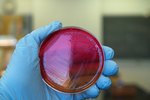Redwater disease in cattle is almost always fatal. It's the result of ingesting Clostridium haemolyticum, a bacterium found in the soil. The condition's formal name is bacillary hemoglobinuria. Though found throughout the world, in the United States the disease is confined primarily to the West.
Once the bacterium enters its bovine host, it heads toward the liver. Redwater disease destroys a cow's red blood cells after the bacteria spread toxins into the bloodstream. Young, apparently healthy cattle are the most vulnerable.
Signs and Symptoms
Symptoms generally appear within 10 days of Clostridium haemolyticum exposure. Redwater disease comes on suddenly -- your first clue could be finding a dead cow. If rigor mortis has set in quickly, that's a sign your animal succumbed to redwater disease. A necropsy can confirm that redwater disease killed your cow.
Affected animals stop eating and drinking, experience breathing difficulty and spike a fever, and dairy or nursing cows stop lactating. Jaundice and anemia occur. Feces turn dark, and the animal is obviously suffering from abdominal pain. A pregnant cow usually aborts within several hours, dying shortly thereafter. Cattle who aren't pregnant may live for a few days. The telltale sign of the disease is the passing of dark red urine, from which it received its nickname.
Treating Redwater Disease
If treated in the early stages, there's a slight chance an affected animal can survive. Treatment consists primarily of an anti-toxin serum, along with antibiotic therapy. Your vet might also administer intravenous fluids and give the sick animal blood transfusions.
Vaccinating for Redwater Disease
It's likely you vaccinate your herd for clostridial diseases annually. You can avoid the loss of your stock by vaccinating for redwater disease, but make sure the vaccines you use are effective against Clostridium haemolyticum. Simply read the labels before purchasing vaccines or make sure you know which diseases the vaccine covers if ordering online. Ask your vet if redwater disease is an issue in your region. If there is a high incidence of the disease, she may recommend semi-annual vaccinations. Vaccinate calves at the age of 3 months, and each animal should have either an annual or semi-annual booster shot.
Writer Bio
Jane Meggitt has been a writer for more than 20 years. In addition to reporting for a major newspaper chain, she has been published in "Horse News," "Suburban Classic," "Hoof Beats," "Equine Journal" and other publications. She has a Bachelor of Arts in English from New York University and an Associate of Arts from the American Academy of Dramatics Arts, New York City.




